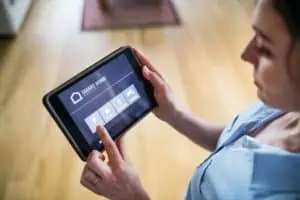Window treatments comprise a major piece of the interior (and exterior) design puzzle. As something so important, you would think most homeowners would be knowledgeable about their options. Sadly, this is not always the case.
There are five primary window treatments that are stylish and provide different benefits like efficiency, privacy, and safety. Use this guide to brush up on your options before making any design changes around your home.
1. Jalousies (and Horizontal Louvers)
Jalousies often get lumped into the term horizontal louvers. Contrary to this habit, jalousies are arguably more prevalent than the louvers. What is the difference?
A jalousie is a set of slats (yes, horizontal) that remain parallel as each slat rests in a frame or track. The slats can be operated with a crank or other type of opener. As the opener moves, each slat moves or tilts open and closed at the same time.
A louver, in this case, horizontal louvers, do not open or close. The easiest way to remember is simply to know that jalousies open and shut, while louvers are fixed in one position.
Both of these horizontal slat window treatments trace their origins back to France. They are a great way to shield an interior from the sun. You can find them in interior and exterior settings but mostly indoors in regions with harsh winters.
Another unique use for these treatments is as a way to illuminate an otherwise dark space. Placing reflective materials on the slats themselves can enhance the amount of light entering a room.
2. Vertical Louvers
Horizontal louvers are not the only slats on the block! The less common siblings of them are called vertical louvers. Can you guess why they are called vertical louvers? I am sure you can and have already determined that the slats must run vertically rather than horizontally.
Vertical louvers allow airflow while providing light diffusion and shade. Louvers are fixed, as we learned in the prior section, and can allow a clear view of the outside while providing privacy for those on the interior.
You will typically see sets of vertical louvers on windows that or on eastern or western building faces. This is a direct response to the sun’s behavior throughout the day. Many proponents of vertical louvers suggest that the shading is far more effective than a horizontal louver.
3. Awnings
Awnings are an oft-forgotten member of the window treatment community. Typically made from cloth or other synthetic materials, an awning can provide shade to one window or the entire side of a building.
The look of awnings ranges from industrial to delicate and come in many sizes, shapes, and colors. There are retractable awnings available to allow home or business owners flexibility with the look and feel of the exterior of the building.
The most famous awnings are called brise soleils. These are often large, permanent structures that perform the important function of breaking light up before it hits the glass front of a building. Brise soleils are popular because of their ability to let some light through while preventing horrible glares.
4. Frosted Glass
Window treatments are not always placed around windows but can be applied to them. One way to do this is to frost the glass. There are multiple versions of “frosted glass” including frit and the traditional glaze you imagine when hearing the term frosted.
Fritted glass is less transparent. It is made by applying frit paint, usually in dots or lines. The glass is fired for tempering and the frit becomes a permanent fixture.
Frosting is a modification of the glass. Many frosted glass products are formed with a process called acid etching. One side of the glass is pitted making it impossible to see through. Frosted glass is great for privacy and light reduction but lacks the protection from heat gain (the transmission of heat from the sun to the indoors) that other window coverings do.
5. Screens and Shutters
Here we are at the final window treatment and these are likely the most popular aside from curtains. Screens and shutters are commonly found applied to the outside of a window. However, shutters are finding their way indoors as part of interior design schemes.
There are benefits to having your screens or shutters outside. An interior shutter filters light after it has gotten inside. It is less likely to reduce heat gain than an exterior shutter. If your goal is maximum heat gain protection and light filtering, a shutter on the exterior will be far more beneficial.
Most shutters come in wood, metal, or synthetic materials. Colors are endless and most can be slid, swung, or rolled open and closed. Some shutters are automated, others are controlled mechanically, and some require manual operation.
Screens are frequently lightweight and are fit into a frame. The frame is often fit into the window frame or attached via some sort of clip system. Most screens provide some light filtering and privacy but can still be seen through.
There you have it! Five of the most common window treatments and some useful information about how they fit aesthetically and functionally. Contact your window treatment expert today to discuss how one of these options might fit your interior or exterior design.





